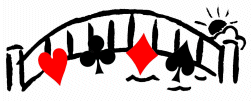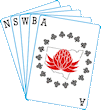• eBulletins
IBPA Award for Richard Jedrychowski
Posted by John Scudder on Thursday, 20 October 2016 at 11:29

At the recent world championships the International Bridge Press Association (IBPA) announced its awards. The award for the Best Played Hand of the Year went to Richard Jedrychowski. Today ABF President, Bruce Neill, presented the award to Richard.
The hand was published by Ron Klinger in the Sydney Morning Herald on 28th May, 2016. With the permission of Ron, it is reproduced below
The force of the Jedi
Take a look at one of Australia's top players, Richard Jedrychowski, affectionately known as Jedi, in action in a rubber bridge game at the Grand Slam Bridge Centre, Double Bay, in Sydney on April 8.
Richard's 1♠ opening is rubber bridge style
West led the ♥2: five – king – three. East shifted to the ♦3: six – king – two. West returned the ♦5, taken by the ♦A. To defeat 3♠, East needed to play another diamond, but he chose the ♣3. The ♣Q won and South continued with the ♠6: two – seven – three and the ♠8: ♦7 – ♠9 – ♠4.
South could tell West's shape almost for certain: four spades (known) and four diamonds (indicated by the play so far). As West had led the ♥2, that would be from 3 or 4 hearts, but if West had 4 hearts, West would have bid 3♥, not 3♦. South gave West three hearts and hence a 4-3-4-2 pattern. West had shown up with ♠A and ♦K. As East won trick 1 with the ♥K, South also placed the ♥Q with West. East might have been deceptive with ♥K-Q, but that was unlikely. There was no reason to fool partner here.
After the first six tricks, these cards remained.
South has lost three tricks already and will lose to the ♠A at some point. How can South come to nine tricks?
It would not work to cross to the ♥A, discard a heart on the ♦J and ruff a heart. If you continue with a spade, West wins and a diamond gives the defence the fifth trick one way or another. A heart to the ace, ♦J to discard your heart loser and then another club finesse will not work either.
With East having four hearts to West's three including the expected ♥Q, Jedi judged that the ♥10 would probably be with East. In that case he could transfer the heart menace by leading the ♥J at a convenient time. At trick 7, Jedi, played the ♠10. West took the ♠A and declarer unblocked the ♠K from dummy, as East discarded a heart. If West had played another spade, East throwing the ♦9, South would win and lead the ♥J, letting it run if West plays low. If West covered, the ♥A wins and the ♦J would squeeze East in hearts and clubs.
After taking the ♠A West was not so kind as to play another spade. He returned a diamond to dummy’s ♦J. This foiled South's initial plan, since the squeeze position is destroyed, whether South discards a heart or a club.
Not to worry, Jedi found the solution. He ruffed the ♦J! Ruffing your own winner is not usually a good idea, but here it was essential. Next came the ♥J: queen – ace – six. East was down to ♥10, ♣K-9-6 and South had ♥9, ♣A-J-4. The ♠J simultaneously drew West’s last trump and squeezed East. Whichever suit East discarded, South would discard from the other suit and repeat the club finesse. Making three spades.
Bridge is a logical game, but being brilliant goes beyond logic. It is seeing what others cannot or do not see.





